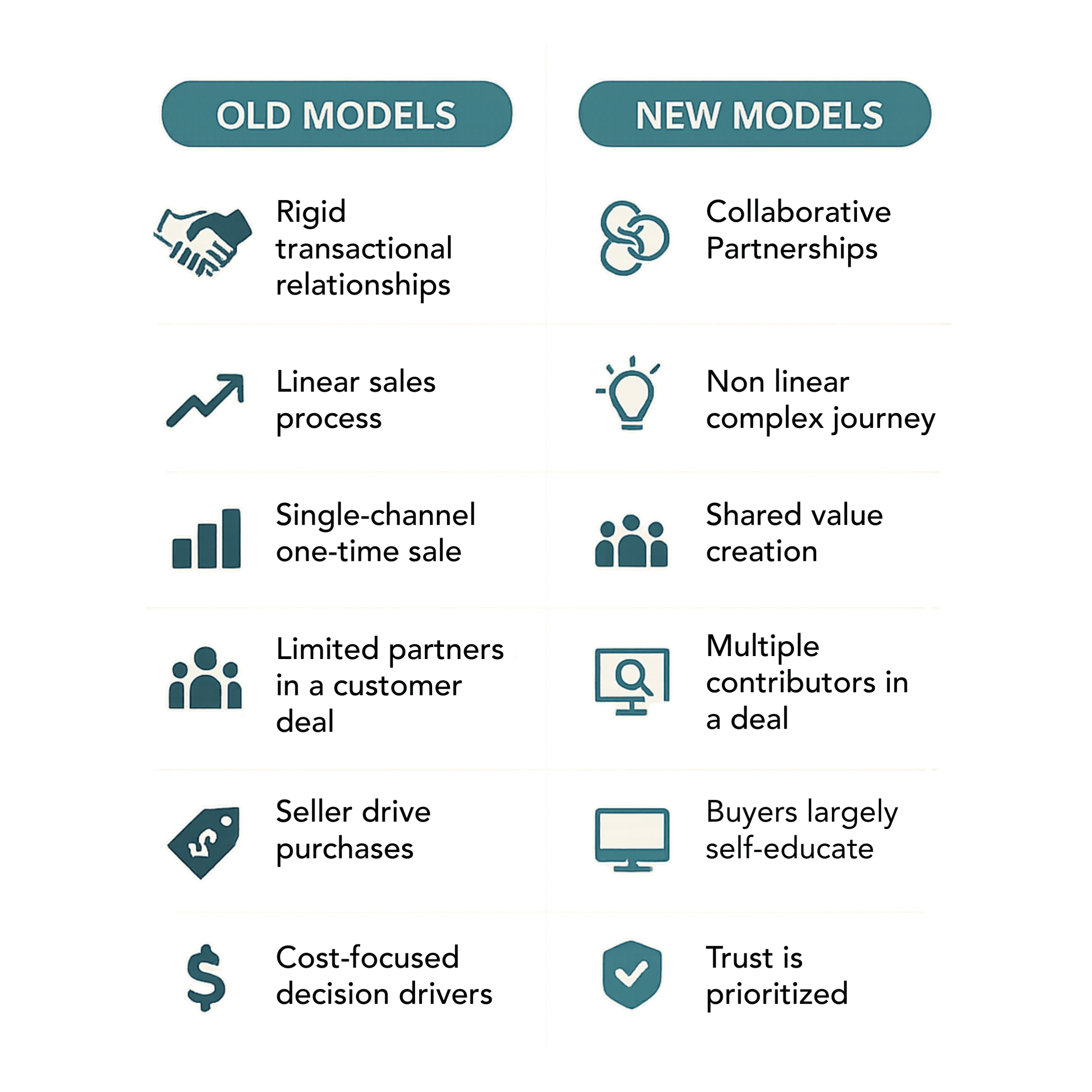We don’t sell the same way anymore. We don’t partner the same way either.
And yet, many businesses are still trying to grow using old partner models that were built for another era. This is the first in a three-part newsletter series on how to succeed in today’s ecosystem-led world.
When I began my tech career, partner programs were built on linear models: vendors built products, recruited resellers, and pushed sales through indirect channels. It was transactional and mostly one-directional, and in a product-centric world, it worked.
But we don’t live in that world anymore. We live in the ecosystem era, and that changes everything.
What’s Changed and Why Old Models Don’t Work Anymore
Today, partnerships look very different: they’re nonlinear, collaborative, and built on shared value creation. Think about how many players are now in a single customer deal: ISVs, Cloud Hyperscalers, MSPs, GSIs, boutique consultancies, and even influencers. All of them play a role in co-innovation, co-marketing, and co-selling. And all of them bring something different to the table.
In the ecosystem era, customers and markets don’t play by the old rules:
- Cloud and subscription models dominate. Customers expect continuous value, not a one-time sale.
- Digital-first buyers do the heavy lifting before talking to sellers. In fact, 84% of deals are decided before many sellers even know them. 6sense
- Buying ecosystems are increasingly complex. Needs and solutions are shaped by multiple contributors: ISVs, hyperscalers, GSIs, and niche specialists.
- Third-party influence has surged. A 2025 study shows 35% of younger buyers involve ten or more external voices in their purchasing decisions, and this is expected to climb to 50% soon. themarketingpractice.com
- Trust matters more than ever. Decision drivers like value alignment, credibility, and alignment with buyer values now outweigh cost and product specs. Marketing Charts
- Ecosystem revenue isn’t shrinking, it’s accelerating. A recent survey found that 67% of organizations expect their partner-generated revenue to grow by more than 30% year-over-year. Forrester
The result? Old partner operating models — focused on transactional resell and basic QBRs — no longer fit. Ecosystem-led growth requires new disciplines, shared accountability, and intelligent insights to orchestrate multiple partners toward a common outcome.
Why Ecosystem Models Drive Better Results
Here’s the good news: when organizations embrace ecosystem-led growth with the right models, the results are stronger, more sustainable, and more customer-centric. Why? When done well, ecosystem-led growth delivers results far beyond what traditional models can:
- Expanded reach and influence. More partners mean you tap into more customers, markets, and industry verticals.
- Rapid co-innovation. Teams who co-create win faster—and build solutions that resonate precisely with customer needs.
- Stickier customer value. Ecosystem solutions are bundled, integrated, and often delivered by trusted consultative partners—making them hard to replace.
- Shared investment and accountability. When partners co-invest—structurally and financially—they also build deeper trust and alignment. And the data supports this. A recent report shows:
The Data speaks for itself:
- 68% of companies say having a partner involved increases deal close rates.
- 26% say partner-influenced deals outperform the rest of the pipeline.
- 64% of their new customers come through partner-influenced or co-sell motions.
This is why ecosystems are becoming the primary growth engine for the most successful organizations today.
How AI Accelerates Ecosystem Growth
One of the most exciting enablers of ecosystem-led growth today? Artificial Intelligence. It helps make the complex more manageable and scalable.
AI makes it possible to:
- Spot pipeline risks early, before they derail forecasts.
- Identify which joint plays are working in-market.
- Highlight underutilized partners with high potential.
- Free up leaders to focus on coaching and strategy instead of chasing down reports.
Think of AI as the connective tissue that brings intelligence, efficiency, and predictability to the ecosystem model. Learn more about how to apply AI in partner programs for better performance and planning here
Let’s Turn Ecosystem Potential into Predictable Growth!
The ecosystem era demands new thinking. But you don’t have to navigate it alone. At AchieveUnite, we’ve had great success helping many companies through this critical partnership transition. Please reach out to me at theresa@achieveunite.com with any questions or concerns.
One of the most powerful and complex capabilities in ecosystem-led models is co-selling. When done right, it unlocks deeper trust, pipeline acceleration, and scalable partner impact. But only if you’re ready.
📈 Curious how your organization stacks up? Take our Predictive Co-Selling Maturity Assessment to benchmark your readiness and uncover your next moves.
Frequently Asked Questions
1. What is ecosystem-led growth in the tech industry?
Ecosystem-led growth refers to a strategy where companies drive revenue and innovation by partnering across a network of technology vendors, hyperscalers, consultancies, and influencers. It replaces linear selling with co-creation and co-selling models.
2. Why are traditional partner models no longer effective?
Traditional models were built for transactional reselling in a product-centric world. Today’s digital-first, subscription-driven buyers expect continuous value and influence from multiple ecosystem contributors.
3. What is co-selling, and why does it matter in ecosystem strategies?
Co-selling is a collaborative sales approach where multiple partners jointly engage prospects, leveraging their combined credibility, insights, and solutions. It’s one of the most powerful drivers of ecosystem success.
4. How can AI enhance ecosystem-led growth strategies?
AI helps companies analyze partner data, forecast performance, identify high-potential collaborations, and automate routine tasks—making ecosystem orchestration smarter and more scalable.
5. How do I know if my organization is ready for ecosystem-led co-sell growth?
You can evaluate your co-sell readiness using tools like AchieveUnite’s Predictive Co-Selling Maturity Assessment, which benchmarks your capabilities across alignment, enablement, and execution.



